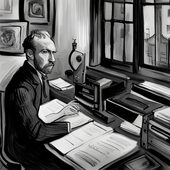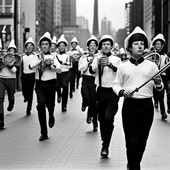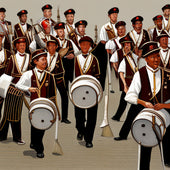Student leadership is a vital component of a band program. Even in the smallest of schools, having a leadership structure helps to take some of the pressures off the instructional staff (and the band director). By and large, the instructional information should come from adults hired to teach - but numerous other organizational tasks still function better by students guiding one another and handing down institutional knowledge. Additionally, only some 14-year-olds will inherently have the intrinsic motivation that makes band kids so unique. Having other young adults to look up to will help those newer members develop that sense of responsibility and individual contribution that will make your band function smoothly.
So, how do you choose who your leaders will be?
Two of the worst mistakes that happen too often are 1) selecting leaders because they're just the best players in the band or 2) picking students based on personal preference. Let's be fair: the kids who are best cut out to be the leaders have gotten to that point because they ARE the kids who the directors like, which also tends to have a lot of overlap with the kids who can play their instruments the best - but being the best player doesn't mean they're also cut out to guide the younger members of your band.
What should the leadership selection process look like?
First and foremost, there should be a written application process. It doesn't necessarily need to be lengthy and verbose, meaning more reading (read: work) for you. But it should have enough questions to make your potential leaders think a bit and also make them have to put some effort in. After all, what is student leadership except a burden that demands extra effort from those students? If they aren't willing to put effort into the application, they will be equally lackluster as leaders.
Feel free to let your leadership application reflect your personality a bit and allow the students to let their own personalities shine through. One of my favorite applications I've read (from a friend) always asks students which kitchen utensil they would be. On top of incredibly creative answers, it is always fun to see what things the kids consider utensils (hint: "dishwasher" is not a correct answer). Questions like these have no right answer provided the response is thoughtful and reasoned.
Band programs tend to demand so much time from everybody that if it were purely business all the time, everyone would get burnt out. It's okay to be human, and letting the leadership process reveal some humanity is a great way to develop the rapport that makes leadership function.
A great addition to this process is to include recommendations from other teachers. We view our band kids (especially the potential leaders) positively, so it would be insightful to see what other teachers think of your kids - get that "second opinion." Keep in mind what your own workload is like. As you develop your teacher recommendation system, find ways to keep it as simple and streamlined as possible (again, less work for you - and as you minimize your impact on your colleagues, they'll be more apt to respond well).
After you've collected your leadership applications, seek to get input from other stakeholders. If you are fortunate enough to have other instructional staff, share the applications around and let everyone create independent reactions to the applications before conferring as a team. If you're one of the heroic directors who does it all as a solo venture, see if you can find another teacher in your building, another band director in your feeder system, or any other trusted colleague to read the applications. Even if those folks don't know your kids, they should be able to get a feel for the kids by reading their applications.
The next step I strongly advocate for is to have leadership clinics. Any band student should be invited to these clinics. By including everybody in this Leadership Tapas event, even those students who will not be on your final leadership roster will get a taste of what leadership is all about. The more students you have who know how to act a leader, the band will run far more smoothly.
These clinics should introduce two or three leadership topics to the students so they can start to think about leadership. To make this a part of your application process, structure the clinics in a seminar/conversational format. This requires the students to talk and contribute. Your two-pronged benefit to this is that you get more details on your selection process, and you also get to see who contributes and who goes along for the ride.
Finally, depending on the program size and how much time you want to invest, a great final step for leadership selection is live interviews. This will allow you to ask questions of the kids to shore up any lingering holes in their candidacy, and it will also give you a chance to see how the students will act under pressure. Depending on people's availability (and willingness!), it's sometimes fun and insightful to ask an administrator or outside director to be a part of your interview panel. This is an unbiased (or less biased) viewpoint, and it adds a little additional pressure to the students by not being as familiar a face.
Throughout the whole process, find a way to quantify your reactions. Teaching is very human, and it is absolutely valid to let your human responses to the students play a role in the selection process. But you will inevitably face some tough decisions. By creating a quantification system, you can get one more bit of data that will help you see A vs. B. One student may get more "points" than another, which could help inform your final selection.
Once you've made your final leadership list, it's essential to give those not selected a measure of reassurance and to encourage them to still act as leaders, even without a title. Keep them involved and engaged so they also remain invested and dedicated performers.
Also, remember that even your experienced leaders are still students and young adults. This should be the beginning of their leadership journey. Look ahead for additional posts on leadership training and accountability for thoughts on continuing to develop those students' leadership.






























